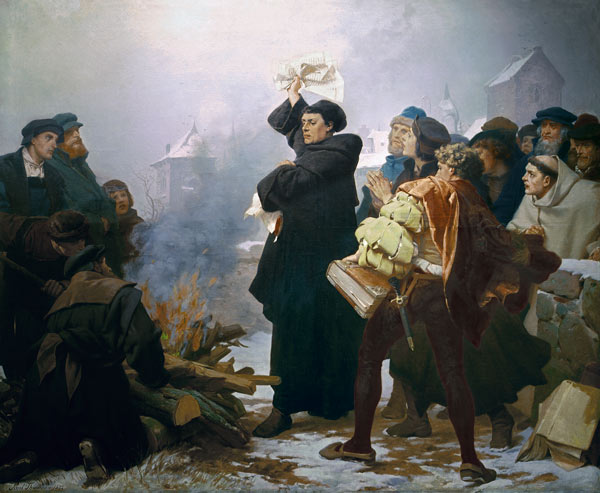26 June 2016

Martin Luther burns Pope Leo X’s Papal Bull, Exsurge Domine, which threatened him with excommunication unless he recanted within a sixty day period. Luther refused to recant and responded instead by composing polemical tracts lashing out at the papacy and by publicly burning a copy of the bull on December 10, 1520. (Thumann)
Jesus Christ, a Jewish rabboni, or “teacher”, alarmed the Temple authorities by daring to come back to life. “OK, so we killed him, but only for three days”, runs the Jewish joke. Christianity began with a crucified body that went missing – but was it really a Jewish body? Martin Luther’s austere, reforming personality would not allow for Christ’s Jewish blood because Jews fed off satanic excrement. “The devil stuffs and squirts them so full that it overflows and swims out of every place,” Luther preached.
The German theologian was aware of the Hebraic roots of the Bible. (Matthew’s gospel, the most demonstrably “Jewish” of the four, seeks to show how every recorded act of Jesus is rooted in Jewish scripture.) Yet Luther called for German Jewry’s complete cultural eradication. Small wonder his antisemitism was co-opted by the Third Reich. His virulent Jew-baiting was no mere relic of Catholic antisemitism; it was integral to Protestant identity and a Protestant sense of election as God’s anointed people. As Lyndal Roper writes in her excellent and wholly absorbing biography, Luther argued repeatedly that Jews did not belong to the German race. Instead, they were a contaminant akin to the Nazis’ Fremdkörper – an alien body within the nation.
In many ways, Luther’s campaign to “restore” Biblical Christianity to 16th-century Germany was a battle for land and national supremacy. Catholics, no less than Jews, were seen by Luther as a supranational sect inimical to the sturdy bond of Germanic race and nationhood. His animus against Rome served not only to unite Germans against the papacy, but strengthened their territorial sovereignty. Protestant artist friends of Luther’s, such as Dürer, Holbein and Lucas Cranach, brazenly attacked the “burdens and abuses” of the pope, and thus helped to ensure that an impressive 50 of Germany’s 65 imperial states had adopted the Reformation by the late 16th century.
Unlike other biographers of Luther, Roper concentrates on the churchman’s childhood. Luther was born in Eisleben in northern Germany in 1483 but grew up in the provincial mining town of Mansfeld, a Dantean hellpit of smouldering slagheaps and furnaces. Luther’s father, a well-off smelting master, wanted young Martin to marry into money; instead, in a flagrant act of disobedience, he became a tonsured Augustinian monk. Monastic sexual continence did not suit the mine owner’s son, however, and in 1525 Luther married a former nun, Katharina von Bora. It was no longer a requirement for priests to be celibate.
In Roper’s analysis, Luther’s rebellion against his father anticipated his attacks against the pope. The “father” of the Roman church was a “sodomite” and a “transvestite”, who had subjected the Christian family to levels of “Satanic” abuse. Always a good hater, Luther scorned Marian veneration as a form of idolatary and the papal mass as a black sabbath by another name. Only the Bible –sola scriptura – could decide matters of liturgy and doctrine. The scriptures were superior to the authority of popes, councils, church fathers, the Virgin Mary and all those glittering blessed saints.
On 31 October 1517 Luther nailed (or perhaps glued: history is unclear) his 95 theses to the door of Wittenberg’s Castle church and so sparked off what became known as the Protestant Reformation. Understandably, Luther saw the Catholic sale of indulgences as a money-making scandal. Congregations were gulled into a false sense of salvation through the payment of fees. (“As soon as the coin in the coffer rings, the soul from purgatory springs”, ran a preacher’s advertising jingle.)
Luther was not the first to criticise the un-Christian mechanism of cash-for-salvation. Two centuries before him, in Decameron, Boccaccio had bemoaned the “clever rascality” of priests who hoodwinked their way to wealth and sexual gratification. Yet no church figure before Luther (certainly not in north Europe) had attacked Rome with such a ribald energy and moral indignation. In his pulpit rantings there was something of the huckster or cult leader. Luther was a man who looked “neither left nor right” in his polemics, says Roper: the reformation took the direction it did largely because of his authoritarian personality.
As the reformation spread across Europe, vernacular versions of the Bible became a useful weapon of protest. Luther’s translations of the Old and New Testaments loaded and vivified the German language with coinages that are still in use. Like William Tyndale in England, Luther daringly translated the Greek ekklesia as “community” or “congregation” rather than “church”. Congregational singing – an innovation of the Lutheran revolt – allowed the faithful to become participants in church worship rather than remain mute spectators. By the time he died in 1546, at the age of 62, Luther had set in motion a doctrinal and liturgical revolution that swept all before it; Europe would never be the same again.
Today, on the eve of the Reformation’s 500th anniversary, Germany is a unified democratic republic with a powerful Lutheran church that in some ways still disdains the Vatican and any whiff of ornament. Conceivably, Luther’s assault on Catholic Europe in 1517 helped to usher in modern secularism in the west. His frank attitude to human sexuality, too, was quite forward-looking and certainly a break from late medieval Christian asceticism. Roper’s biography, distinguished by the excellence of its writing and research, is the beginning of wisdom in all things Reformation, anti-Roman and, alas, proto-Hitlerite. Rarely has a church reformer presented such a dubious side.
Martin Luther: Renegade and Prophet is published by Vintage (£30). Click here to buy it for £24
No comments:
Post a Comment